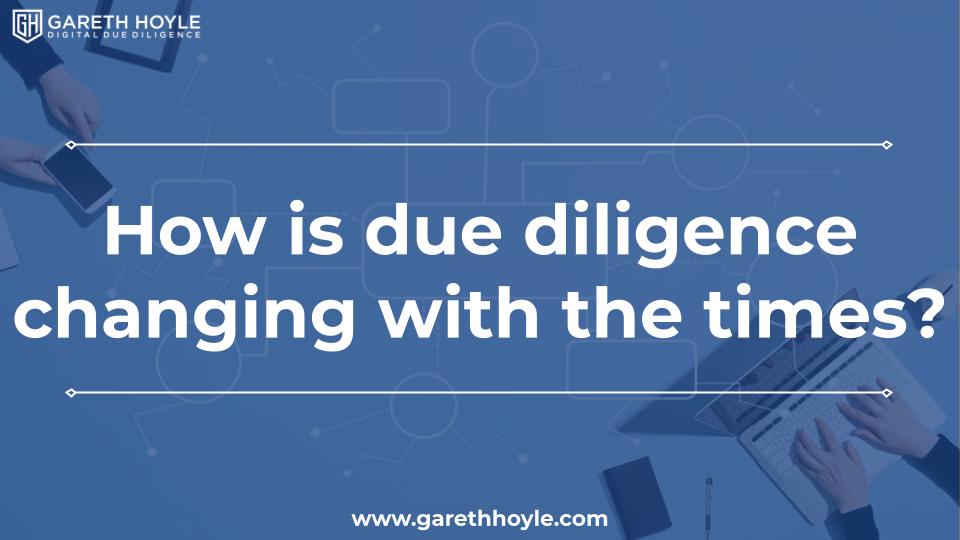The coronavirus pandemic has left a lasting legacy on day-to-day business operations. The unprecedented level of digital disruption – caused by ensuing market uncertainties – means many companies now rely on M&A (merger and acquisitions) to steady the ship via broader revenue streams and faster access to in-demand skills.
Due diligence has necessarily gone through changes to adapt to the challenges of the new global marketplace. As one quick example, there is perhaps now a greater emphasis on providing a deeper and more insightful analysis of how to successfully navigate M&A without folding one company’s operations entirely into the working practices of the other. The aim of M&A is to develop all existing revenue streams – not to merely eliminate a competitor and expand the workforce.
Jump Sections
The Pillars of M&A (in Relation to Due Diligence)
Digital due diligence is an essential part of M&A. Here’s why. Many companies undertake either a merger or acquisition in the belief – and hope – that the outcome will naturally include an increase in online visibility, growth in lead generation, and a wider market share.
However, where digital due diligence is not carried out in full, the outcome of your M&A efforts is likely to be far from expected. The reason comes down to a lack of planning around data-driven insights, resulting in not being able to hit the ground running (counterintuitively, your merger or acquisition could end up costing you more time and money where a need to react and develop unforeseen but essential business practices becomes unavoidable).
That is why we must consider the basic pillars of M&A and look at how digital due diligence is changing with the times.
Past Performance
Analysing and reporting on the past performance of a company is a critical step in digital due diligence prior to any merger or acquisition.
In the post-pandemic business world, the usual means of assessing a company’s output, readiness, and adaptability are no longer as valid as they used to be.
Instead, we now need to focus on the decisions and outcomes that helped the company to remain viable when shifting operations to a predominantly digital setup.
- Did the company merely survive the pandemic?
- Are the decisions that helped now slowly unravelling?
- Or is there a robust plan? And how can it tie in with your brand?
Current Business Model & Leadership
Business leaders are best placed to understand all developing issues facing the vendors and consumers that populate a digital ecosystem.
Digital due diligence can provide a deep dive into the current practices of leaders and project how a leader’s value can add to your business.
Conversely, due diligence at this stage could also reveal data on business leaders and their current models that could go against reasoned strategies.
Due diligence tools can also ascertain public perceptions of the target, helping to drive insights over PR requirements (and projected cost-effectiveness of PR).
Is the Acquirer Ready to Become a Corporate Parent?
As a result of pandemic lockdown measures, the business world has moved even more significantly towards online operations than ever before.
That is why digital due diligence now looks ever more critically at the readiness of the acquirer to become a corporate parent.
For example,
- How does your brand rank in digital literacy?
- Could you lead another brand?
- Are the relevant structures in place?
- What would need to change?
If you do not make the necessary preparations, M&A may result in more work for both companies as your practices struggle to accommodate the change.
Readiness to Scale
M&A rarely takes place without the desire to exploit shared resources and scale the resulting joint enterprise in ways that would not have otherwise been possible.
Preparing to scale a brand requires careful analysis of relevant metrics and a thorough understanding of how existing hierarchies must adapt to the challenge.
Acquire or Merge (would a reverse takeover approach work)?
Digital due diligence has evolved to include new ways to ascertain whether your company stands to benefit from a merger with a target brand versus attempting an acquisition.
The process may begin with basic investigations, including:
- Web-traffic analysis & reporting
- Competitor performance over time
- Social engagement (range of metrics)
- Geographic coverage (brand engagement)
- Your capacity to absorb or support the target’s workforce
From the results of these investigations, your brand is better placed to make data-driven decisions over whether a merger or acquisition is more suitable in the current digital climate.
For example, consider the reverse takeover approach. If the results of due diligence reveal that your company is equipped with the capability to allow continued complete autonomy (with support) on behalf of the target business, you may be suited to an acquisition. However, if due diligence were to uncover that your internal readiness is lacking in such a capacity, a merger may be more beneficial for both entities.
Digital Due Diligence in the Modern Era
Due diligence has grown to incorporate all considerations over how mergers and acquisitions can adopt best-practice strategies in the post-pandemic digital workspace.
For more information on whether your brand is ready for M&A, and to begin to understand how data-driven cost-effective preparations can help plug any gaps before moving forwards, get in touch today.
Your initial consultation is FREE – it costs nothing to discover how digital due diligence can help map and nurture your merger or acquisition. Get in touch today.
